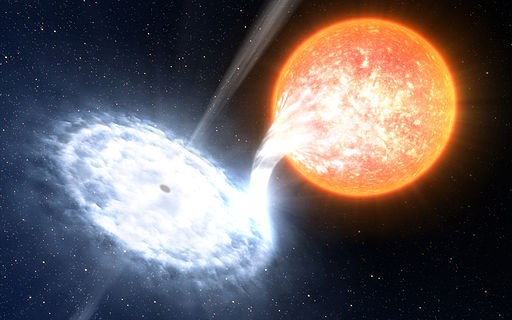Researcher's Math Deems Black Holes Impossible
| Marc Maligalig | | Sep 25, 2014 04:39 PM EDT |
(Photo : Wikimedia Commons)
Black holes? They could be non-existent, after all.
By combining two contradictory theories, Laura Mersini-Houghton, a physics professor from the University of North Carolina at Chapel Hill in the College of Arts and Sciences, has mathematically proven that there has never been, and there will never be, any black holes in outer space.
Like Us on Facebook
While the work of Mersini-Houghton would not only pressure researchers to rethink the fabric of space-time, it would also force them to re-imagine the origins of the universe.
I'm still not over the shock," said Mersini-Houghton. "We've been studying this problem for a more than 50 years and this solution gives us a lot to think about."
Black holes, regions of space-time that have immense gravities preventing everything from escaping, were previously thought to be born after a huge star collapses under its own gravity into a singularity, or one point in space.
To put things into perspective, one must imagine the size of the Earth, then compress the planet to the size of a peanut.
The previous theory suggested that an invisible membrane, known as the event horizon, encompasses the singularity, and traversing the horizon means one can never come back. It is the point where the gravitational pull of the black hole is tremendously strong, nothing can tear away from its grip, not even light.
Black holes are strange as it puts two fundamental theories of the universe in a proverbial fight-to-the-death. Albert Eisnten's law of quantum theory states that nothing in the universe can ever disappear, and his theory of gravity predicts that black holes, which casts what it devours into the depths of oblivion, can be formed.
Efforts to put the two theories together always lead to mathematical nonsense, which has since became known as the "black hole information paradox."
Back in 1974, English theoretical physicist, cosmologist and author Stephen Hawking, used quantum mechanics to demonstrate that black holes give off radiation. Since then, researchers have identified distinct characteristics in the universe consistent with Hawking's theoretical radiation, identifying an increasing list of black holes in the cosmos.
However, Mersini-Houghton's data suggests a whole new scenario. She and Hawking both agree that when a star collapses into itself, it generates Hawking radiation. But in Mersini-Houghton's new computations, she shows that by releasing the radiation, the dying star sheds its mass enough that as it becomes smaller, it no longer has the density to become the black eating machine.
Just before a black hole can form, the dying star increases its size one last time and then detonates itself. As a result, a singularity and an event horizon is never created.
TagsStar, Dying star, Stephen Hawking, Hawking radiation, Gravity, Universe, Origin of Universe, Big Bang, Space Time, Space, TIME, Space Time, spacetime
©2015 Chinatopix All rights reserved. Do not reproduce without permission
EDITOR'S PICKS
-

Did the Trump administration just announce plans for a trade war with ‘hostile’ China and Russia?
-

US Senate passes Taiwan travel bill slammed by China
-

As Yan Sihong’s family grieves, here are other Chinese students who went missing abroad. Some have never been found
-

Beijing blasts Western critics who ‘smear China’ with the term sharp power
-

China Envoy Seeks to Defuse Tensions With U.S. as a Trade War Brews
-

Singapore's Deputy PM Provides Bitcoin Vote of Confidence Amid China's Blanket Bans
-

China warns investors over risks in overseas virtual currency trading
-

Chinese government most trustworthy: survey
-

Kashima Antlers On Course For Back-To-Back Titles
MOST POPULAR
LATEST NEWS
Zhou Yongkang: China's Former Security Chief Sentenced to Life in Prison

China's former Chief of the Ministry of Public Security, Zhou Yongkang, has been given a life sentence after he was found guilty of abusing his office, bribery and deliberately ... Full Article
TRENDING STORY

China Pork Prices Expected to Stabilize As The Supplies Recover

Elephone P9000 Smartphone is now on Sale on Amazon India

There's a Big Chance Cliffhangers Won't Still Be Resolved When Grey's Anatomy Season 13 Returns

Supreme Court Ruled on Samsung vs Apple Dispute for Patent Infringement

Microsoft Surface Pro 5 Rumors and Release Date: What is the Latest?










